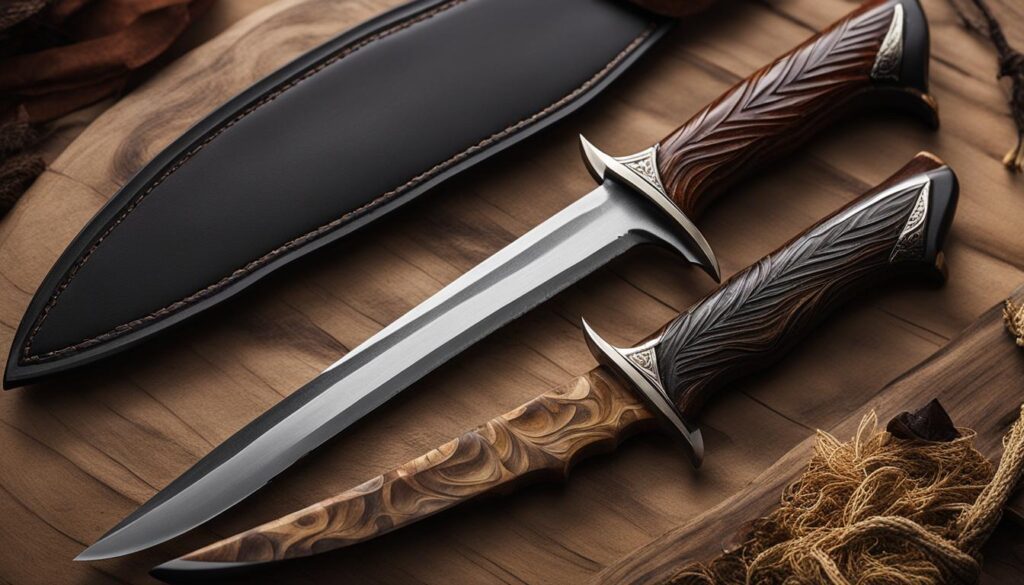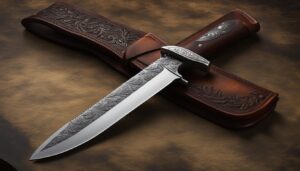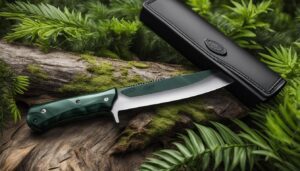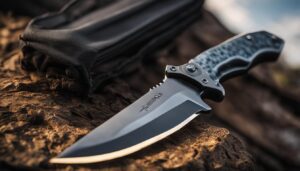The proper weight and handling efficiency of a hunting knife are essential for achieving precision and ensuring safety in your outdoor adventures. Finding the right balance between these factors can greatly impact the overall performance of your knife. So, how do weight and handling efficiency play a crucial role in optimizing your hunting experience?
Weight distribution is key when it comes to a comfortable grip and reducing fatigue during use. By optimizing the weight distribution, you can enhance your grip and handle the knife with ease. This allows for more precise cuts and improved control, ensuring that your every move is accurate and safe.
The art of balance in a hunting knife involves a combination of factors such as design, materials, and craftsmanship. Each element contributes to the overall performance of the knife and can make a significant difference in your hunting experience.
Key Takeaways:
- Weight and handling efficiency are crucial for the performance of a hunting knife.
- Optimizing weight distribution enhances grip and reduces fatigue.
- The art of balance involves design, materials, and craftsmanship.
- Precision and safety in hunting depend on the proper weight and handling efficiency of the knife.
- Choosing a hunting knife with the right balance can greatly enhance your hunting experience.
Understanding Knife Handles: The Key to Weight Handling Efficiency
The handle of a hunting knife is a crucial component that directly impacts weight handling efficiency. It plays a significant role in achieving the right balance and providing a comfortable grip for precision and safety during use. Different types of handles, including those with bolsters, contribute to the overall weight distribution and strength of the knife.
Handles with bolsters offer added balance and strength, allowing for optimal weight distribution. These bolstered handles can also be strategically designed to add weight where needed, further enhancing the knife’s balance. The choice of handle material is another important factor to consider. Materials such as aluminum or bone can affect the weight and overall performance of the knife.
Grip retention is crucial for safe and efficient knife handling. The handle material and its surface treatment greatly influence grip retention. A well-designed handle with proper texturing or contouring can improve grip, ensuring a secure hold even in challenging conditions. By understanding the importance of knife handles, hunters can select a hunting knife that offers optimal weight handling efficiency, resulting in improved control and enhanced performance in the field.
Table: Types of Knife Handles and their Features
| Handle Type | Features |
|---|---|
| Bolstered handle | Provides balance and strength |
| Aluminum handle | Lightweight and durable |
| Bone handle | Traditional aesthetic and sturdy |
The Evolution of Handmade Hunting Knives: Balancing Tradition and Innovation
Handmade hunting knives have a long and storied history that stretches back for centuries. Craftsmen around the world have honed their skills and refined their techniques to create knives of exceptional quality and performance. These knives are the embodiment of tradition and innovation, blending the time-honored artistry of the past with the advancements of the present.
Early handmade hunting knives were crafted using primitive materials such as bone and stone. These knives served their purpose well, but as mankind developed new metalworking techniques, iron and steel became the materials of choice. The durability and sharpness of steel allowed for more efficient hunting and ensured that the knives could withstand the rigors of the hunt.
Today, artisans use a wide range of high-quality steel alloys, such as Damascus steel, to create handmade hunting knives that are both functional and visually stunning. Damascus steel is renowned for its exceptional strength and distinctive patterns, which are achieved through a meticulous process of layering and folding the metal. This ancient technique, dating back to the Middle Ages, results in knives that are not only superior in performance but also unique works of art.
Preserving Tradition, Embracing Innovation
While the craftsmanship and materials used in handmade hunting knives have evolved over time, artisans have also preserved the traditional elements that define these knives. From the intricately carved handles to the meticulously shaped blades, each knife is a testament to the skill and dedication of its maker.
At the same time, innovators in the industry have embraced modern technology to further enhance the performance and reliability of handmade hunting knives. Advanced heat treatment processes and computer-aided design have allowed artisans to fine-tune the hardness, flexibility, and overall balance of the blades. This fusion of tradition and innovation has resulted in knives that offer uncompromising quality, durability, and precision.
The Legacy Continues
The legacy of handmade hunting knives continues to thrive as craftsmen pass down their knowledge and expertise to the next generation. Each knife carries with it a rich history and a connection to the past, making it more than just a tool, but a symbol of tradition and heritage.
As hunters seek out the perfect companion for their outdoor adventures, they can take comfort in knowing that the artistry and innovation inherent in handmade hunting knives will continue to evolve, ensuring that these timeless tools remain a staple in the hunting community for generations to come.

Why Handmade Hunting Knives Are Superior
Handmade hunting knives are considered superior due to their exceptional quality, durability, and customization options. Crafted with meticulous attention to detail by skilled artisans, these knives offer outstanding performance and reliability in the field. When compared to mass-produced knives, handmade hunting knives stand out for their superior craftsmanship and unparalleled functionality.
One of the key factors that contribute to the superiority of handmade hunting knives is their quality. Each knife is carefully crafted using the finest materials and techniques, resulting in a blade that is sharp, durable, and built to last. These knives are designed to withstand the rigors of hunting, ensuring that they remain reliable and effective in various hunting situations.
Furthermore, handmade hunting knives offer a high level of customization and personalization. Hunters have the opportunity to choose the blade material, handle design, and other features according to their preferences and specific needs. This customization not only adds a personal touch but also ensures that the knife is perfectly suited to the individual hunter’s style and requirements. Whether it’s a unique handle material or a personalized engraving, these customizations make each handmade hunting knife truly one-of-a-kind.
Overall, the combination of superior quality, durability, and customization options makes handmade hunting knives the preferred choice for serious hunting enthusiasts. With their exceptional craftsmanship and personalized features, these knives provide hunters with a reliable and personalized tool that enhances their hunting experience.


Choosing the Perfect Handmade Hunting Knife: Considerations for Blade Materials and Design
When it comes to choosing the perfect handmade hunting knife, there are several important factors to consider. The blade material and design play a significant role in determining the knife’s performance, durability, and overall functionality. Let’s explore the key considerations for blade materials and design that will help you make an informed decision.
Blade Materials
The choice of blade material is crucial, as it directly impacts the knife’s performance and durability. There are several options to consider, each with its own unique characteristics:
- Stainless Steel: Stainless steel blades offer excellent corrosion resistance and durability. They are easy to maintain and are less prone to rusting, making them a popular choice for hunting knives.
- Carbon Steel: Carbon steel blades have excellent edge retention, allowing for long-lasting sharpness. However, they may require more maintenance to prevent corrosion.
- Damascus Steel: Damascus steel is renowned for its strength, cutting performance, and unique pattern. It is crafted by layering different types of steel together, creating a visually stunning blade that combines both form and function.
Blade Shape and Handle Options
Aside from blade materials, the shape of the blade and the available handle options also deserve consideration.
- Blade Shape: Different blade shapes serve specific purposes. The drop point blade is versatile and suitable for various tasks, while the clip point blade provides excellent precision and control. The gut hook blade is designed specifically for field dressing game.
- Handle Options: The handle material and shape significantly impact the knife’s functionality and comfort. Common handle materials include wood, bone, and synthetic materials like G-10 or Micarta. The handle shape should provide a secure grip and ergonomic feel, ensuring optimal control during use.
By considering these factors, you can choose the perfect handmade hunting knife that meets your specific needs and preferences. Whether you prioritize durability, cutting performance, or personal style, the right combination of blade materials and design will ensure an exceptional hunting experience.
| Blade Material | Key Characteristics |
|---|---|
| Stainless Steel | Corrosion resistance, durability |
| Carbon Steel | Excellent edge retention |
| Damascus Steel | Strength, cutting performance, unique pattern |
Choosing the perfect handmade hunting knife involves careful consideration of blade materials, design, and handle options. By understanding the characteristics of different blade materials and the significance of blade shape and handle options, you can select a knife tailored to your hunting needs. Whether you prioritize durability, cutting performance, or personal style, the right combination of factors will ensure that your hunting knife is a reliable companion in the field.
“A well-chosen hunting knife becomes an extension of the hunter’s hand, enabling precise cuts and enhancing the overall hunting experience.”
Conclusion
In conclusion, weight and handling efficiency are crucial factors in the performance of a hunting knife. The balance achieved through the optimized weight distribution and handle design provides comfort, control, and enhanced precision during use. Proper handling techniques further improve the efficiency of the knife, allowing for more precise cuts and overall better control.
The choice of blade materials and design also significantly impact the durability, sharpness, and functionality of the knife. Whether it’s stainless steel, carbon steel, or the unique patterns of Damascus steel, selecting the right blade material is essential for a hunting knife that meets the demands of the field.
Handmade hunting knives, with their superior craftsmanship and attention to detail, offer unmatched quality and customization options. They provide not only a functional tool but also a connection to the rich tradition of knife-making. By understanding the importance of weight and handling efficiency, hunters can choose the perfect handmade hunting knife, ensuring a balance of precision and safety in their hunting endeavors.
FAQ
How does weight and handling efficiency affect the performance of a hunting knife?
Weight and handling efficiency play a crucial role in the performance of a hunting knife. The balance between the weight of the blade and the way it is handled affects the precision and safety of the knife. The weight distribution should be optimized to provide a comfortable grip and reduce fatigue during use.
What role does the knife handle play in weight handling efficiency?
The knife handle is an essential component that contributes to weight handling efficiency. Different types of handles, such as those with bolsters, provide balance and strength to the knife. The choice of handle material and its surface treatment can affect the weight and overall performance of the knife. Grip retention is also highly dependent on the handle material and design.
How have handmade hunting knives evolved over time?
Handmade hunting knives have a rich history that spans centuries. They have evolved over time, incorporating new materials and techniques while maintaining the craftsmanship and traditions of the past. Early handmade hunting knives were crafted from bone and stone, but with the advancement of metalworking techniques, iron and steel became the preferred materials. Today, artisans use high-quality steel alloys like Damascus steel to create unique hunting knives.
What makes handmade hunting knives superior?
Handmade hunting knives excel in quality and performance due to the meticulous craftsmanship and attention to detail. Each knife is crafted by skilled artisans, resulting in superior durability, sharpness, and overall functionality. Handmade hunting knives also offer customization options, allowing users to personalize the blade and handle according to their preferences.
What factors should be considered when choosing a handmade hunting knife?
When choosing a handmade hunting knife, several factors need to be considered. The blade material, such as stainless steel or carbon steel, can impact the knife’s performance and durability. The blade shape, such as drop point or gut hook, should also be considered. Additionally, the handle options, including materials and shape, contribute to the overall functionality and comfort of the knife.





